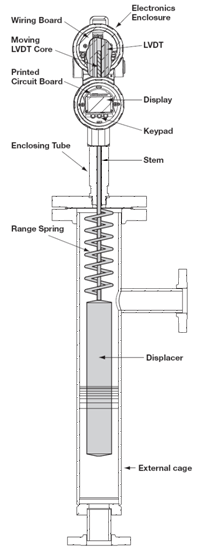Displacer level transmitter is used in Process measurements
of liquids across many process industries. In this article we discuss the
Principle of operation and industrial level applications that displacer
transmitter technology offers.
Principle of Operation
Operation is based on buoyancy force. The buoyancy
force works on the displacer which will vertically move in (increasing liquid
level) and out (decreasing liquid level) the linear differential transformer
(LVDT). Due to this movement, voltages are induced in the secondary winding of
the LVDT. These signals are then processed in the electronic circuitry and used
to control the output signal.
Industrial Applications
Displacer transmitters are ideal solution for
liquids or slurries, clean or dirty and light hydrocarbons to heavy acids with
a specific gravity (SG) of 0.23 to 2.20.
Displacer transmitter technology works well in a
variety of vessels including process & storage, bridles, bypass chambers,
interfaces, sumps and pits up to unit pressure and temperature ratings. They
can also handle most liquid conditions including varying dielectric, vapors,
turbulence, foam, buildup, bubbling or boiling and high fill/empty rates.
Some of the specific industrial applications include:
Boiler control – The displacer unit provides a stable output signal
for valve control on turbulent surface applications, such as feed water heaters,
flash tanks, and reactors.
Interface control on storage tanks
– The displacers are tolerant of
emulsions. They can track towards middle of emulsion, and are tolerant of
unstable interface. They also ignore vapor/liquid interface point above
displacer.
Mixing Tank – The displacer transmitter can also be used in harsh
production environments like those in a mixing tank. It provides a stable
output, easier to configure and is resistant to heavy surging caused by the
mixer.
Water elevation – The displacer can be used to maintain a water
elevation at a given height by sending out a proportional 3-15 PSIG signal
(over a 14 ″ control band) to a control valve to maintain water level at
midpoint by regulating the water flow rate out of the separator. The control
valve is fully open at 15 PSIG input and fully closed at 3 PSIG input.
You can also read: Ultrasonic Level Measurement Technology
In Summary the advantages and
limitations of Displacer transmitter include:
Advantages
- Stable signal in turbulent applications
- High Pressure/Temperature capabilities
- No flexure of pressure boundary part
Limitations
- Shifting SG can affect this technology
Some of the manufactures of Displacer level
transmitters include:
Sources: Magnetrol
Don't miss out on our Instrumentation updates, join our newsletter list here

No comments:
Post a Comment